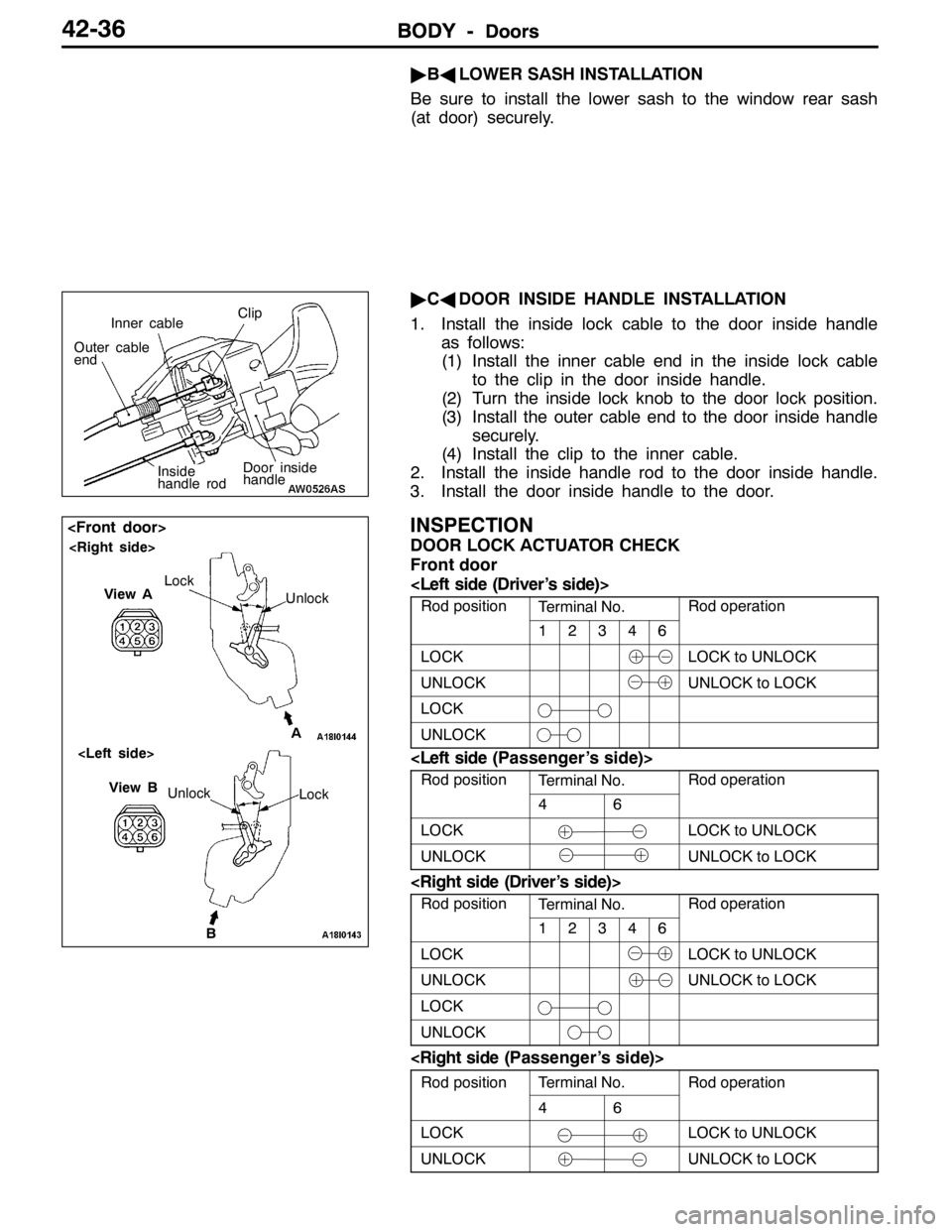Page 1123 of 1449

STEERING -On-vehicle Service37A-9
POWER STEERING FLUID LEVEL CHECK
1. Park the vehicle on a flat, level surface, start the engine,
and then turn the steering wheel several times to raise
the temperature of the fluid to approximately 50 - 60_C.
2. With the engine running, turn the wheel all the way to
the left and right several times.
3. Check the fluid in the oil reservoir for foaming or milkiness.
Check the difference of the fluid level when the engine
is stopped, and while it is running. If the change of the
fluid level is 5 mm or more, air bleeding should be done.
POWER STEERING FLUID REPLACEMENT
1. Raise the front wheels on a jack, and then support them
with rigid racks.
2. Disconnect the return hose connection.
3. Connect a vinyl hose to the return hose, and drain the
oil into a container.
4. Disconnect the ignition coil connectors. (Refer to
GROUP16 - Ignition System.)
5. While operating the starting motor intermittently, turn the
steering wheel all the way to the left and right several
times to drain all of the fluid.
6. Connect the return hoses securely, and then secure it
with the clip.
7. Fill the oil reservoir with specified fluid up to the lower
position of the filter, and then bleed air.
Specified fluid:
Automatic transmission fluid DEXRONII
Caution
Do not use ATF-SPIIM and ATF-SPIII.
POWER STEERING SYSTEM BLEEDING
1. Jack up the vehicle and support the front wheels with
rigid racks.
2. Disconnect the ignition coil connectors. (Refer to
GROUP16 - Ignition System.)
3. Cranking the engine with the starter several times
intermittently (during 15 to 20 seconds), turn the steering
wheel left and right fully five or six times.
Caution
(1) During the bleeding, refill the fluid so that the
level never falls below the lower position of the
filter.
(2) Be sure to bleed air only while cranking. If the
bleeding is done with the engine running, the air
will be broken up and absorbed into the fluid.
4. Connect the ignition coil connectors and idle the engine.
5. Turn the steering wheel left and right fully until no bubbles
comes out in the oil reservoir.
6. See that the fluid is not milky and that the fluid level
is up to the specified position on the level gauge.
7. See that the fluid level changes little when the steering
wheel is turned left and right.
8. Check difference in fluid levels between the engine
stopped and running.
Fluid level change: Within 5 mm
While engine
runningWhile engine
stopped
Return hose
Vinyl hose
Page 1131 of 1449

STEERING - Power Steering Gear Box and Linkage37A-17
17 6 2
3 4
15±3 N·m
57±7 N·m
5
70±10 N·m
Removal steps
1. Crossmember
(Refer to GROUP 32.)
2. Joint cover grommet
3. Return hose connection4. Return tube
5. Pressure hose connection
6. Clamp
7. Steering gear and linkage
INSPECTION
GEAR BOX PINION TOTAL ROTATION TORQUE CHECK
Caution
Secure the steering gear box and linkage in their mounting
positions only. Otherwise, deformation or damage could
result.
1. Using the special tool, turn the pinion gear at a speed
of one rotation per 4 to 6 seconds to measure total rotation
torque.
Standard values:
Total rotation torque: 0.8 – 1.8 N·m
Torque fluctuation: 0.49 N·m or less
NOTE
(1) Remove the bellows from the rack housing before
measuring.
(2) Measure the total rotation torque by turning the special
tool left and right 180_from the neutral position.
2. If the standard values are not met, adjust the pinion total
rotation torque. (Refer to P.37A-26.)
3. In case the adjustment is impossible, disassemble and
check the components, and repair if necessary.
MB991006
Page 1141 of 1449

STEERING - Power Steering Gear Box and Linkage37A-27
2. If the total rotation torque or torque fluctuation does not
meet the standard values, adjust by returning the rack
support cover within a range of 0 to 30_.
Caution
(1) Adjust around the maximum limit of the standard
values.
(2) See that no ratcheting or catching are present
when operating the rack towards the shaft
direction.
(3) Measure the total pinion torque through the whole
stroke of the rack.
3. If the adjustment is impossible in the given range, check
the components of the rack support cover, and replace
if necessary.
"LATAB WASHER/TIE ROD INSTALLATION
After installing the tie rod to the rack, fold the tab washer
end (2 locations) to the tie rod notch.
"MABELLOWS BAND INSTALLATION
1. Turn the adjusting bolt of the special tool to adjust the
opening dimension (W) to the standard value.
Standard value (W): 2.9 mm
Screw in the adjusting bolt.
Loosen the adjusting bolt.
NOTE
(1) The dimension (W) is adjusted by about 0.7 mm per
one turn.
(2) Do not turn the adjusting bolt more than one turn.
2. Use the special tool to crimp the bellows band.
Caution
(1) Hold the rack housing, and use the special tool
to crimp the bellows band securely.
(2) Crimp the bellows band until the special tool
touches the stopper.
MB991561
Stopper
Adjusting bolt W
MB991561
Page 1142 of 1449

STEERING - Power Steering Gear Box and Linkage37A-28
3. See that the crimped width (A) meets the standard value.
Standard value (A): 2.4-2.8 mm
Readjust the dimension (W) of step (1) to the value
calculated by the following equation, and repeat step
(2).
W = 5.5 mm-A [Example: If (A) is 2.9 mm, (W)
is 2.6 mm.]
Remove the bellows band, readjust the dimension
(W) of step (1) to the value calculated by the following
equation, and use a new bellows band to repeat steps
(2) to (3).
W = 5.5 mm-A [Example: If (A) is 2.3 mm, (W)
is 3.2 mm.]
"NATIE ROD END/LOCKING NUT INSTALLATION
Screw in the tie rod end until the dimension shown is achieved.
Then, temporarily tighten with the locking nut.
NOTE
The locking nut must be tightened securely only after the
power steering gear box and linkage are installed to the vehicle
and toe-in is adjusted.
"OAGEAR MOUNTING RUBBER INSTALLATION
Install the gear mounting rubber to the rack housing so that
the distance is as shown in the illustration.
TIE ROD END BALL JOINT DUST COVER
REPLACEMENT
Only when the dust cover is damaged accidentally during
service work, replace the dust cover as follows:
1. Apply grease to the inside of the dust cover.
2. Drive in the dust cover with special tool until it is fully
seated.
3. Check the dust cover for cracks or damage by pushing
it with finger.
A
Edge of bellows
assembly grooveLocking nut
184 mm
220 mm
MB990776
Page 1182 of 1449
BODY -DoorsBODY -Doors42-34
"BAOPERATION CHECK
window>
1. Install the glass to the window regulator assembly.
Caution
(1) As fully open position which is programed in the
power window-ECU is released (initialized), the
window regulator assembly should not be
operated until it is installed to the glass.
(2) The clamping prevention function does not
operate the first time that the glass is fully closed.
2. Press the power window switch to fully-open the glass,
and then return the glass toward the fully-close position
about 30 mm each. In the fully-close position, keep on
pressing the power window switch for 0.5 second or more.
NOTE
This operation will program the power window-ECU.
INSPECTION
POWER WINDOW RELAY CONTINUITY CHECK
Battery voltageTerminal No.yg
1345
Not applied
Applied
Power window
relay
123
4
5
Page 1184 of 1449

BODY -DoorsBODY -Doors42-36
"BALOWER SASH INSTALLATION
Be sure to install the lower sash to the window rear sash
(at door) securely.
"CADOOR INSIDE HANDLE INSTALLATION
1. Install the inside lock cable to the door inside handle
as follows:
(1) Install the inner cable end in the inside lock cable
to the clip in the door inside handle.
(2) Turn the inside lock knob to the door lock position.
(3) Install the outer cable end to the door inside handle
securely.
(4) Install the clip to the inner cable.
2. Install the inside handle rod to the door inside handle.
3. Install the door inside handle to the door.
INSPECTION
DOOR LOCK ACTUATOR CHECK
Front door
Rod positionTerminal No.Rod operation
12346
LOCKLOCK to UNLOCK
UNLOCKUNLOCK to LOCK
LOCK
UNLOCK
Rod positionTerminal No.Rod operation
46
LOCKLOCK to UNLOCK
UNLOCKUNLOCK to LOCK
Rod positionTerminal No.Rod operation
12346
LOCKLOCK to UNLOCK
UNLOCKUNLOCK to LOCK
LOCK
UNLOCK
Rod positionTerminal No.Rod operationp
46
p
LOCKLOCK to UNLOCK
UNLOCKUNLOCK to LOCK
Door inside
handle
Inner cableClip
Outer cable
end
Inside
handle rod
B Unlock
View B
Lock
View A
Unlock Lock
A
Page 1197 of 1449
EXTERIOR -Front Bumper51-5
"BARIVET INSTALLATION
Use the recommended tool shown in the illustration to secure
the rivet in the following procedure.
1. Insert the rivet into the main materials (front bumper face
and front bumper side plate.)
2. Insert the recommended tool into Part A of the rivet.
3. Maneuver the handle of the tool pressing the flange of
the rivet.
4. Particles of Part A of the rivet are cut off to be secured.
AC"FRONT BUMPER CENTER NET REMOVAL
Tighten the front bumper center net mounting bolt from the
vehicle centre line.Riveter
Bumper side
plate
Part A
Riveter
Rivet
Flange part
1
2
3
4Bumper face
Rivet
Bumper face
Vehicle
centre
: Bolt installation position
Page 1200 of 1449
EXTERIOR -Rear Bumper / Side Air Dam, Molding and Garnish51-8
REASSEMBLY SERVICE POINTS
"AARIVET INSTALLATION
Use the recommended tool shown in the illustration to secure
the rivet in the following procedure.
1. Insert the rivet into the main materials (rear bumper face
and rear bumper side plate.)
2. Insert the recommended tool into Part A of the rivet.
3. Maneuver the handle of the tool pressing the flange of
the rivet.
4. Particles of Part A of the rivet are cut off to be secured.
SIDE AIR DAM, MOLDING AND GARNISH
SPECIAL TOOL
ToolNumberNameApplication
MB990449Window molding
removerRemoval of roof drip molding
ADHESIVE
ApplicationBrand
Side air damDouble-sided tape [5 mm width 1.2 mm thickness]
Riveter
Bumper side
plate
Part A
Riveter
Rivet
Flange part
1
2
3
4Bumper face
Rivet
Bumper face